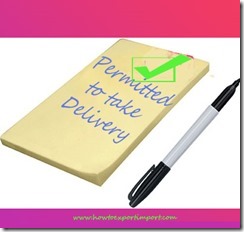The information provided here is part of Online export import business guide course
Delivery Order in import – How to release goods from Shipping company?
The term ‘Delivery Order’ is used in Imports and Exports at two different areas. Delivery Order in terms of delivery of goods by carrier and Delivery of empty container for stuffing by sea carriers.
Here we discuss about Delivery Order in terms of Delivery of Goods to consignee by carrier.
What is Delivery Order? When does shipping company release Delivery Order? How to release goods from Shipping Company?

Delivery order is the order given by carrier to the party to take delivery of goods. Once cargo arrived at port of destination, the goods are moved to customs bonded area where in customs clearance procedures are carried out. If the cargo is Less Container Load (LCL), it is stored in the container freight station warehouse. The import cargo will be under the custody of CFS authorities whoacts as ‘custodian of cargo’.
Custodian of cargo can be a private party, semi-government, or fully owned by government authorities. However, custodian of cargo in a bonded area can release the goods to the party only with the permission of Customs authorities and the carrier of cargo. The carrier of cargo means, the shipping, freight forwarding or transport company who carries goods to the port of final destination. Once after arrival of cargo at final customs port of destination, the said carrier of goods issues delivery order to consignee (or his order) after collecting necessary charges if any. The importer or his customs broker completes import customs formalities by filing necessary documents and inspection of cargo procedures completes if applicable. Once after completion of import customs formalities, the importer or his authorized agent approaches custodian of cargo along with the delivery order issued by carrier of goods to release the cargo. The custodian of cargo verifies the proof of completion of import customs clearance procedures and delivery order, release the cargo to importer.
Along with delivery order, carrier need to collect original bill of lading issued by his counterpart at port of loading pertaining to the said shipment unless otherwise the said document surrendered or released as ‘Sea Way Bill’. Also read Surrender of Bill of Lading – Some facts What is Express Release Bill of Lading Is Seaway bill a document of title? What is Seaway bill.
Consignee “To Order” in Bill of Lading
I hope, I could satisfy about this simple term ‘Delivery Order’ in imports and exports.
Would you like to share your experience and thoughts about DO – Delivery Order in Exports and Imports?
The above information is a part of Guide on howtoexport and import
How does CFR term of delivery work in Export Import business
What is CIF terms of delivery in Exports and Imports?
Explain DDU terms in export import trade. What is DDU delivery
HAWB/HBL number missed on Parcel. How to take delivery of imported goods
Other details on how to import export
DO in exports – Delivery Order in Export trade
Consol IGM manifest procedures
Difference between IGM and Gateway IGM
IGM amendment (Import General Manifest Amendment)
Consol DO and liner
POD Proof of Delivery – How important in Imports
CTM Cargo Transfer Manifest
What is Test Report in Import clearance
Excise and Customs - Click here to read complete notification under Budget 2014
How to get Export Orders?
How to settle dispute in Exports and Imports?
Click here to know India Trade Classification(ITC)
Click here to know HS code of other product/commodity
Pre shipment bank finance to suppliers for exports through other agencies
Types of export containers
Measurement of export containers
Export Import Policy of India 2015-20
MEIS, Merchandise Exports from India Scheme
SEIS, Service Exports from India Scheme
Merge your Commercial Invoice and Packing List for all your future exports
Export procedures and documentation
Factory stuffing procedures after GST implementation
Import of goods attracts IGST but not CVD under GST regime
Import goods attracts IGST and CVD under GST regime
Import Goods attract IGST, CVD and Compensation Cess under GST regime
Safeguard duty and Anti-dumping duty after GST implementation
Authority for advance ruling, Section 96 of CGST Act, 2017
Section 94 of CGST Act, 2017 Liability in other cases
Liability to pay tax, interest or penalty in certain cases, Sec 93 CGST Act
Section 90 Liability of partners of firm to pay tax, CGST Act, 2017
Liability of agent and principal, Sec 86 of CGST Act, 2017
Revised GST rate on Other non-alcoholic beverages
Revised GST rate on Sulphur recovered as by-product in refining of crude oil
Revised GST rate on Marble and travertine, other than blocks
Revised GST rate on Granite, other than blocks
Revised GST rate on Uranium Ore Concentrate